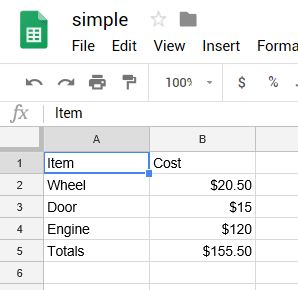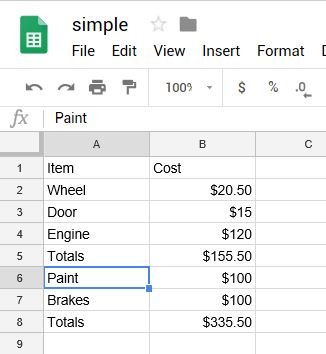|
|
(PowerShell) Google Sheets - Append Values to an Existing Spreadsheet
Appends values to an existing Google spreadsheet. Note: This example requires Chilkat v11.0.0 or greater.
Add-Type -Path "C:\chilkat\ChilkatDotNet47-x64\ChilkatDotNet47.dll"
$success = $false
# This example requires the Chilkat API to have been previously unlocked.
# See Global Unlock Sample for sample code.
# This example uses a previously obtained access token having permission for the
# Google Sheets scope.
# In this example, Get Google Sheets OAuth2 Access Token, the access
# token was saved to a JSON file. This example fetches the access token from the file..
$jsonToken = New-Object Chilkat.JsonObject
$success = $jsonToken.LoadFile("qa_data/tokens/googleSheets.json")
if ($jsonToken.HasMember("access_token") -eq $false) {
$("No access token found.")
exit
}
$http = New-Object Chilkat.Http
$http.AuthToken = $jsonToken.StringOf("access_token")
# To append values to an existing spreadsheet, our HTTP request body will
# contain JSON in the format of a "ValueRange". For example, the spreadsheet we'll be
# adding to in this example looks like this:
#  # The JSON ValueRange for the cells in the above spreadsheet is:
# {
# "range": "Sheet1!A1:B5",
# "majorDimension": "ROWS",
# "values": [
# [
# "Item",
# "Cost"
# ],
# [
# "Wheel",
# "$20.50"
# ],
# [
# "Door",
# "$15"
# ],
# [
# "Engine",
# "$100"
# ],
# [
# "Totals",
# "$135.50"
# ]
# ]
# }
# This example will append 6 cells (3 rows / 2 columns).
# We'll be appending the following:
#
# "Paint", "$100"
# "Brakes", "$100"
# "New Total", "$335.50"
#
# The range of cells we'll be appending is A1:B5
# Therefore, the ValueRange JSON we'll be sending in our POST body is:
# {
# "range": "Sheet1!A1:B5",
# "majorDimension": "ROWS",
# "values": [
# [
# "Paint",
# "$100"
# ],
# [
# "Brakes",
# "$100"
# ],
# [
# "New Total",
# "$335.50"
# ]
# ]
# }
$json = New-Object Chilkat.JsonObject
$json.UpdateString("range","Sheet1!A1:B5")
$json.UpdateString("majorDimension","ROWS")
$json.I = 0
$json.J = 1
$json.UpdateString("values[i][j]","Paint")
$json.J = 1
$json.UpdateString("values[i][j]","$100")
$json.I = 1
$json.J = 0
$json.UpdateString("values[i][j]","Brakes")
$json.J = 1
$json.UpdateString("values[i][j]","$100")
$json.I = 2
$json.J = 0
$json.UpdateString("values[i][j]","Totals")
$json.J = 1
$json.UpdateString("values[i][j]","$335.50")
$json.EmitCompact = $false
$($json.Emit())
# Send the POST to:
# https://sheets.googleapis.com/v4/spreadsheets/{spreadsheetId}/values/{range}:append?valueInputOption=USER_ENTERED
$http.SetUrlVar("spreadsheetId","1_SO2L-Y6nCayNpNppJLF0r9yHB2UnaCleGCKeE4O0SA")
$http.SetUrlVar("range","Sheet1!A1:B5")
$resp = New-Object Chilkat.HttpResponse
$success = $http.HttpJson("POST","https://sheets.googleapis.com/v4/spreadsheets/{$spreadsheetId}/values/{$range}:append?valueInputOption=USER_ENTERED",$json,"application/json",$resp)
if ($success -eq $false) {
$($http.LastErrorText)
exit
}
$("response status code = " + $resp.StatusCode)
$("response JSON = " + $resp.BodyStr)
# Sample output:
#
# response status code = 200
# response JSON = {
# "spreadsheetId": "1_SO2L-Y6nCayNpNppJLF0r9yHB2UnaCleGCKeE4O0SA",
# "tableRange": "Sheet1!A1:B5",
# "updates": {
# "spreadsheetId": "1_SO2L-Y6nCayNpNppJLF0r9yHB2UnaCleGCKeE4O0SA",
# "updatedRange": "Sheet1!A6:B8",
# "updatedRows": 3,
# "updatedColumns": 2,
# "updatedCells": 6
# }
# }
#
# Our Google Spreadsheet now looks like this:
#
# The JSON ValueRange for the cells in the above spreadsheet is:
# {
# "range": "Sheet1!A1:B5",
# "majorDimension": "ROWS",
# "values": [
# [
# "Item",
# "Cost"
# ],
# [
# "Wheel",
# "$20.50"
# ],
# [
# "Door",
# "$15"
# ],
# [
# "Engine",
# "$100"
# ],
# [
# "Totals",
# "$135.50"
# ]
# ]
# }
# This example will append 6 cells (3 rows / 2 columns).
# We'll be appending the following:
#
# "Paint", "$100"
# "Brakes", "$100"
# "New Total", "$335.50"
#
# The range of cells we'll be appending is A1:B5
# Therefore, the ValueRange JSON we'll be sending in our POST body is:
# {
# "range": "Sheet1!A1:B5",
# "majorDimension": "ROWS",
# "values": [
# [
# "Paint",
# "$100"
# ],
# [
# "Brakes",
# "$100"
# ],
# [
# "New Total",
# "$335.50"
# ]
# ]
# }
$json = New-Object Chilkat.JsonObject
$json.UpdateString("range","Sheet1!A1:B5")
$json.UpdateString("majorDimension","ROWS")
$json.I = 0
$json.J = 1
$json.UpdateString("values[i][j]","Paint")
$json.J = 1
$json.UpdateString("values[i][j]","$100")
$json.I = 1
$json.J = 0
$json.UpdateString("values[i][j]","Brakes")
$json.J = 1
$json.UpdateString("values[i][j]","$100")
$json.I = 2
$json.J = 0
$json.UpdateString("values[i][j]","Totals")
$json.J = 1
$json.UpdateString("values[i][j]","$335.50")
$json.EmitCompact = $false
$($json.Emit())
# Send the POST to:
# https://sheets.googleapis.com/v4/spreadsheets/{spreadsheetId}/values/{range}:append?valueInputOption=USER_ENTERED
$http.SetUrlVar("spreadsheetId","1_SO2L-Y6nCayNpNppJLF0r9yHB2UnaCleGCKeE4O0SA")
$http.SetUrlVar("range","Sheet1!A1:B5")
$resp = New-Object Chilkat.HttpResponse
$success = $http.HttpJson("POST","https://sheets.googleapis.com/v4/spreadsheets/{$spreadsheetId}/values/{$range}:append?valueInputOption=USER_ENTERED",$json,"application/json",$resp)
if ($success -eq $false) {
$($http.LastErrorText)
exit
}
$("response status code = " + $resp.StatusCode)
$("response JSON = " + $resp.BodyStr)
# Sample output:
#
# response status code = 200
# response JSON = {
# "spreadsheetId": "1_SO2L-Y6nCayNpNppJLF0r9yHB2UnaCleGCKeE4O0SA",
# "tableRange": "Sheet1!A1:B5",
# "updates": {
# "spreadsheetId": "1_SO2L-Y6nCayNpNppJLF0r9yHB2UnaCleGCKeE4O0SA",
# "updatedRange": "Sheet1!A6:B8",
# "updatedRows": 3,
# "updatedColumns": 2,
# "updatedCells": 6
# }
# }
#
# Our Google Spreadsheet now looks like this:
# 
|

